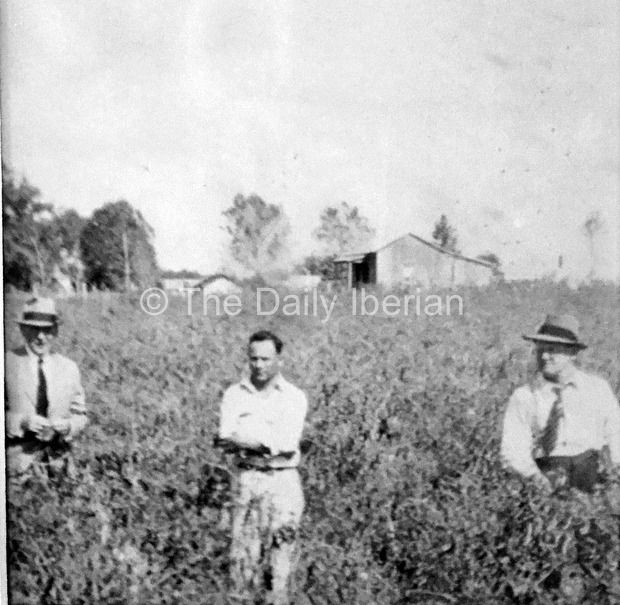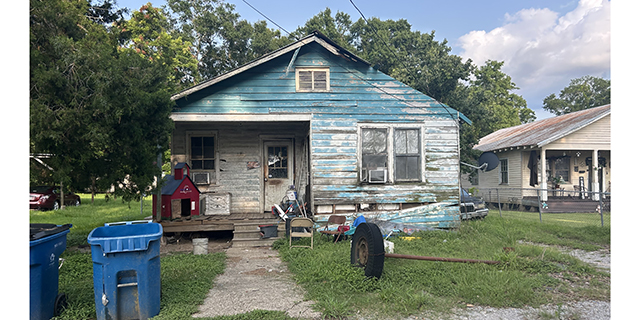Honoring ancestors
Published 2:00 pm Monday, September 7, 2015

- Ancestors of New Iberia residents, Mary Weber Landry and Jerome Weber, grew peppers in the fields along Louisiana 31 between New Iberia and St. Martinville.
ST. MARTINVILLE — Anna Soprano Foti of St. Martinville, loves her life and loves the area, she said, although it has not always been easy.
Her mother and father immigrated separately crossing the Atlantic by freighter. The passengers huddled together on the ship’s topside fending off the elements, while food was stored below deck to preserve it for the long voyage, Foti said.
“It took a month to come over by boat from Italy. They landed in New Orleans and Papa went to Opelousas to pick cotton,” she said. “He moved to Charenton and opened up a general store and shoe repair shop.”
Foti, now 86, and her brothers would deliver groceries in a horsedrawn wagon all around Charenton, the area where the casino is now located. Foti said those were all her customers.
“The Indians were always there. They couldn’t go to school with us even though they were the purest of Americans,” Foti said. “They were not allowed to ride our bus. If they wanted to continue their education beyond eighth grade, they had to go to Arizona where they had higher education for them.”
Foti said she didn’t understand the segregation of the cultures back when she was growing up and doesn’t like it today.
“Mama had nine boys straight, then she had me and another girl,” Foti said. “Italian people are very hard workers. They’re bashful. They learned not to be noticed because we were criticized for being Italian, especially at school.”
As an Italian, she experienced prejudice against her heritage. She would go to socials and the boys wouldn’t dance with her because she was Italian. She said girlfriends couldn’t come to her house for overnights or vice versa, Foti said, because parents didn’t want their children associated with Italians.
“Italians are very proud people,” Foti said, “once I was refused, Mama never wanted to hear that again so I stopped asking.”
Therefore, when Mrs. Soprano learned an Italian boy was interested in her daughter, the last child to marry, she started making wedding plans or as Foti put it, “she started packing my suitcase.” In reality, Foti dated her husband for six months before they married. She was the only one to marry an Italian.
The Fotis have three sons and one daughter, all with Italian names. Maria, Gerard Megella, Peter and Carlo who collectively have given them 10 grandchildren. As a widow, Foti said being family oriented has turned out to be a good thing.
“I have the most wonderful family,” Foti said. “I’ve been blessed since they were born.”
The location for her shop in St. Martinville, C’est Jolie, was built by her husband when they first married. An ancient tree in the back of her property, estimated to be older than the Evangeline Oak, she said, was used by youngsters in the old days to sit up in the tree to watch boats coming up and down the Teche.
When time permits, anyone interested in stories from the Teche Area are welcome to reminense with Foti and plan great things for the future of St. Martinville.
German Ingenuity
John Gutekunst can trace his ancestors back to significant influences in the Teche region. His great-grandfather, Charles Gutekunst, immigrated from Germany with a university degree in civil engineering. The elder Gutenkunst laid out Longfellow-Evangeline State Park as a surveyor. He also ran Civilian Conservation Corps Camps, a public work relief program that operated from 1933 to 1942 for unemployed, unmarried men during the depression.
Charlie Gutekunst’s son, Octave “Otto” Gutekunst Sr., John Gutekunst’s grandfather, was also a civil engineer trained at Tulane and Loyola and helped with surveying.
John Gutekunst’s father, was one of nine children born to Otto Gutekunst in St. Martinville. He worked in the sugar business.
“My father was No. 6 in his family, and he had nine children also,” Gutekunst said. “I was born here while he was managing St. John plantation. I grew up living in the manager’s house at St. John sugar mill, three miles outside of town. I was the only white kid. I didn’t recognize (prejudice),” Gutekunst said.
Between childhood and young adult years, he said they also lived in the Dominican Republic and Haiti, his father working in the sugar cane business.
Gutekunst said his grandmother was a Barras from Point Coupee Parish, true French. They were here before the Acadians moved in and wouldn’t allow mingling with the Cajuns. Gutekunst said his grandfather on his mother’s side immigrated at 12-years-old from England to Canada and then moved down to Loreauville.
“Mother’s great-great grandfather was a Steckler from Germany by way of New Orleans. My great-great-great grandmother on my father’s side was a Mendoza, Spanish by way of the Canary Islands.
Gutekunst was No. 8 of nine children, two boys, seven girls. As a child he would eat at the Paris Café in downtown St. Martinville when it was both a barber shop and café called Thibodeaux’s Café. He said a woman bought the building housing both businesses and combined the two spaces into one. It continued to transition through other owners to become what his family purchased about three years ago.
When the owners put up a ‘For Sale’ sign, he said, they decided to buy it. Their son is the chef.
“We’d like to see St. Martinville come back,” Gutekunst said. “I’d like to see more people open up, but my wife and I have full time jobs, so we have limited time (to be involved in the process). We get a few tourists from France and Belgium but we’d like to see more promotion for the city.”
Gutekunst, 54, made a slight departure from the family business but works with a computer company that he said started in the 1970s writing software for the sugar industry, and others like the oil industry. His roots grow deep in St. Martinville, having also purchased an old Victorian home just off the square.
As Gutekunst did as a child, he often enjoys breakfast in the café facing St. Martin de Tours Catholic Church.
Now he owns it.
All Along the Teche
Local historian Shane Bernard, Ph.D., has recently completed his latest manuscript about Bayou Teche, “a history of Louisiana’s most famous bayou.” He said the cultures identified along Bayou Teche change as you move north from Patterson.
“Patterson through Franklin, up to a vague area between Jeanerette and Franklin, is Anglo-American, Scotch-Irish,” Bernard said. “These settlers came in from Virginia, the Carolinas, Mississippi and other primarily English-speaking areas of Eastern and Southeastern United States. They settled the lower Teche about 1790 on. Even when this area was Spanish, you already had Anglos, coming into the lower Teche.”
“Then somewhere south of Franklin, all the way up to Porte Barre, was primarily French with Spanish around New Iberia. They very quickly started speaking French and married into the French families,” Bernard said.
They all had slaves, he said, but at the end of the war those became free men, wage earners and had to be paid federally approved wages. All former slave owners and freed men had to agree on what that wage would be.
There were also sharecroppers and tenant farmers, a lot of newly impoverished whites who might have previously owned their lands, but were now wage earners.
They were farming sugar cane but also foods they would eat and sell like corn, potatoes and others. St. Martinville south was cane, Bernard said. St. Martinville north was cotton.
“The salt mining population is very interesting because it was a lot more diverse than the rest of the area,” Bernard said. “You not only had locals, but Eastern European immigrants working in the mines.”
Bernard said United States Census information from 1870 showed workers at the Avery Island salt mines were from Bavaria, Russia, Sweden, France, Ireland, Canada, Denmark and England.
The 1880 census added immigrants from Germany, including a Jewish man and his family, Herman Hersh, from Prussia. Ireland and Switzerland were also in that Cenus and the one in 1900 lists Italy and others from Germany.
“There was a lot more pepper grown in Iberia Parish in the past, say from 1900 on,” Bernard said, “because you had the Trappey’s growing their peppers and the New Iberia extract of Tabasco, a separate company from McIlhenny. You also had cattle and horses, construction of rigs and boats, not only at the Port of Iberia and St. Mary, but Patterson. There was a big shrimping industry there.”
Bernard said the shrimp industry is no longer viable in Patterson, though he’s not sure why. It moved to Delcambre and Morgan City.
From 1970 forward, Laotians and Vietnamese came into the area getting away from the political conflict in Southeast Asia, Bernard said. In recent years a lot of Latinos have come in, after Hurricane Andrew but before hurricanes Katrina and Rita.
“The first I noticed large numbers of Latinos coming into the area was after the hurricanes,” Bernard said, “Starting in the late 20th century to the present, they work in sugar refineries and in construction. It’s ironic since it was Spanish territory from 1762 to 1800.”
Although the Continental Spanish were part of the settling of Iberia Parish, he said, the recent growth of the Hispanic population comes as a result of a lot of activity going on between New Orleans, Mexico and the Afro-Caribbean because New Orleans is a major port.
“Barry Ancelet, retired folklorist from ULL (University of Louisiana at Lafayette), likes to point out a lot of people use ‘gumbo’ as a metaphor,” Bernard said. “Although it is a bit cliché, it is useful because the roux came from France. The word gumbo and the concept is from West Africa through the Caribbean.
“Gumbo originally means ‘okra’ in a West African dialect, considered more essential then. Filé is Native American and pepper is Native American introduced by the Spanish traders. You can see all these different influences coming together to make this one dish.”
The first Europeans and slaves to settle here were in 1740s, Bernard said. A lot of people avoided the area because of rumors the Attakapas were cannibals, but that might not be true. He said it could be their enemies, other Indian tribes, who called them Attakapas which means “man eater.” Bernard said the tribe did not call themselves Attakapas and descendents are offended by the rumors.
“Whether it was true or not, the effect was the same in keeping settlers out of the area for a number of years,” Bernard said. “The Chitamachas were already in the Charenton area.
“There are over 75 Indian mounds in the four parishes the Teche travels through. Not all are on the Teche,” Bernard said, “but it goes to show you there was a lot of activity going on. We have an Indian mound on the Island that has been carbon dated to 4,500 years ago, if it is correct.”
“This area was French and Spanish for generations before it became English speaking in the early 20th Century when school attendance forced the culture to convert to English,” Bernard said.
If you want to know more about tracing “gumbo” back to 1764 and all the cultural influences on it, as well as other trivia about the Teche area, visit Shane Bernard’s blog at bayoutechedispatches.blogspot.com. Sometime next year, he expects to have his book published on the colonization along Bayou Teche.





